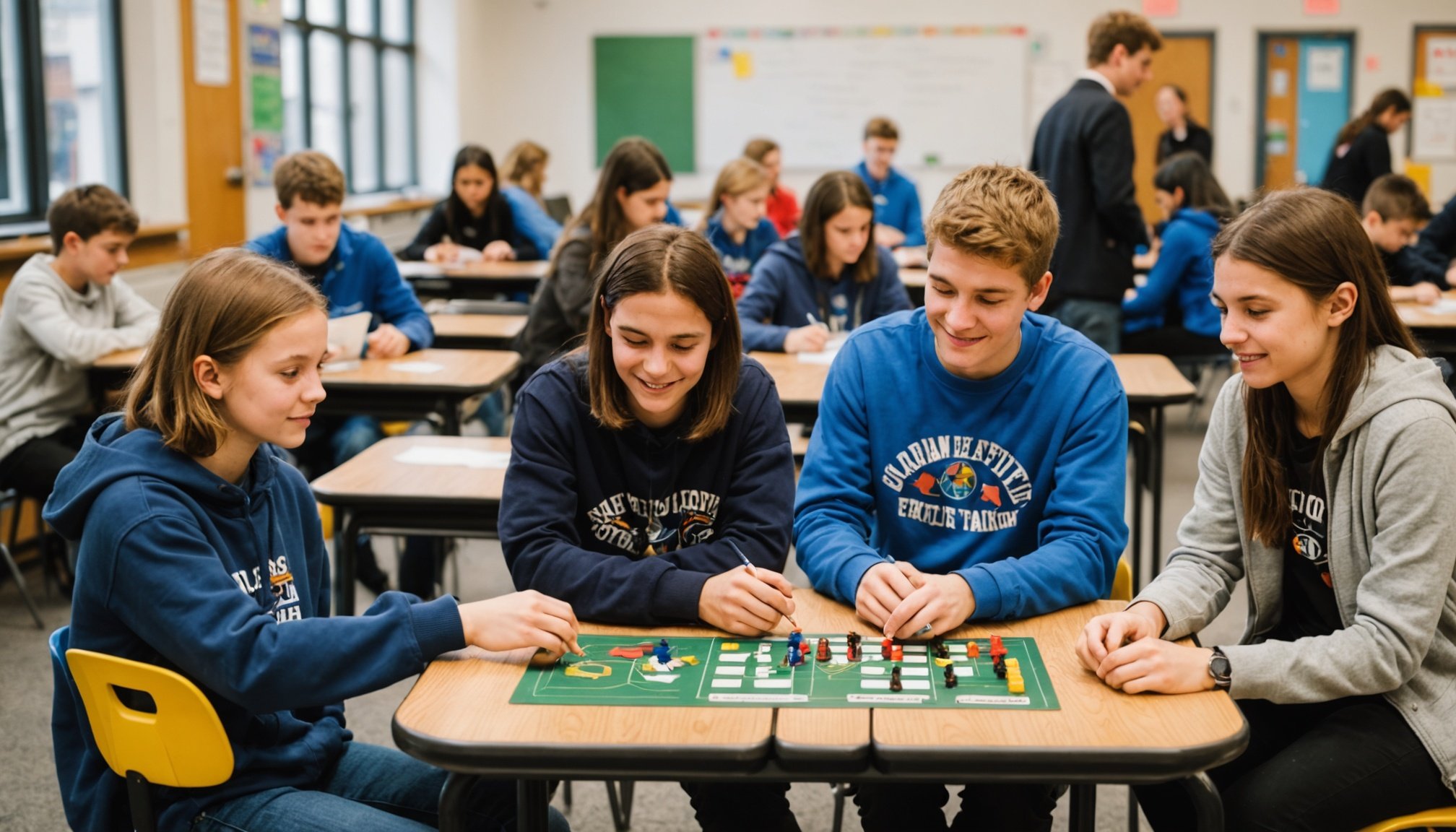Understanding Gamification in Education
In the realm of modern education, gamification stands as a transformative approach designed to enhance student engagement through game-based elements. Essentially, gamification involves incorporating interactive and game-like features into educational practices to foster motivation and involvement among learners. It taps into students’ natural desire for rewards, competition, and achievement, creating an environment where they can explore, participate, and learn actively.
Historically, the concept of gamification in educational techniques has evolved significantly. Originally limited to simple reward systems, it now incorporates complex instructional designs that meshed well with digital technologies. This evolution has been pivotal in building immersive learning experiences that go beyond the traditional classroom setting.
This might interest you : Revolutionizing Project Management: Sheffield Tech Firm Unlocks Success with Agile Strategies
Significantly, innovative techniques have proved crucial in today’s educational landscape, where increased student engagement is more essential than ever. By leveraging the core principles of gamification, educators effectively cater to diverse learning styles, thus encouraging students to take a proactive role in their learning journey. By integrating elements such as point systems, leaderboards, and interactive media, classrooms transform into dynamic spaces that stimulate both curiosity and competitiveness in learning, driving educational success forward.
Examples of Gamification in Manchester’s Schools
Gamification in Manchester’s educational institutions provides an intriguing glimpse into a world where traditional teaching methods blend seamlessly with innovative game-based learning strategies. These examples not only transform classrooms into captivating environments but also demonstrate the immense potential of such techniques in enhancing student engagement.
Additional reading : Designing a Robust Cybersecurity Strategy for Biotechnology Firms in Manchester
Primary School Initiatives
In Manchester, primary schools have been at the forefront of incorporating gamification into their learning environments. For instance, initiatives like “MathsQuest” integrate game mechanics into the teaching of arithmetic, promoting a friendly sense of competition. By using digital platforms, students are rewarded with points for solving problems, which can be exchanged for virtual rewards.
Such projects have resulted in notable outcomes: improved test scores and enhanced student motivation. Teachers have observed that children participate more eagerly when learning feels like play. Students echo these sentiments, expressing enthusiasm about lessons that incorporate game-like features, which they find more relatable and exciting.
Secondary School Innovations
In secondary schools, gamified programs extend to subjects like science and history. Projects often involve simulations and role-playing games to explore complex topics. Studies demonstrate significant performance improvements when these strategies are employed. Collaborations with local organizations have also strengthened program development, fostering an enriching educational atmosphere.
Benefits of Gamification in Enhancing Student Engagement
Gamification has transformed the educational landscape by significantly boosting student motivation and creating engaging learning environments. Research highlights that incorporating game-like elements in education, such as points, levels, and rewards, enhances student engagement by satisfying their intrinsic and extrinsic motivations. Students become more enthusiastic about participating in classroom activities, leading to increased attendance and a desire to excel.
Moreover, gamified learning experiences foster the development of critical thinking and problem-solving skills. Interactive and challenging scenarios encourage learners to think analytically and work collaboratively to solve complex problems. This practical application of knowledge helps in reinforcing concepts and promotes deeper understanding.
Additionally, gamification has shown positive effects on the retention and comprehension of complex subjects. By presenting information in a structured and entertaining manner, students are more likely to remember and understand intricate topics. Gamified lessons allow for revisiting challenging sections and receiving immediate feedback, which solidifies learning.
Ultimately, the integration of gamification in education not only enhances student engagement but also leads to improved learning outcomes. By addressing the diverse needs of learners, it cultivates a dynamic and supportive learning atmosphere that paves the way for academic success.
Practical Implementation Tips for Educators
Integrating gamification into educational settings requires strategic planning and the right tools. Educators can start by aligning game elements with learning objectives to ensure they enhance, rather than distract, from the curriculum. Start simple: gradually introduce points, badges, or leaderboards that acknowledge student achievements, fostering engagement without overwhelming them.
For effective implementation, consider adopting user-friendly platforms like Classcraft or Kahoot, which are designed to facilitate gamified learning experiences. Such tools offer a range of customizable features that can be tailored to fit various classroom activities, making them versatile resources for teachers.
Professional development is crucial for educators aiming to enhance their gamification skills. Workshops and online courses can equip teachers with the necessary expertise, providing insights on crafting immersive and educational gameplay. Building a network with other educators to share experiences and techniques can also prove invaluable.
Ultimately, ensuring a balance between educational content and gameplay is key. Teachers should continuously assess student feedback and outcomes to refine their strategies, ensuring the gamified approach genuinely supports educational goals and accommodates diverse learning needs.
Addressing Challenges and Solutions in Gamification
Implementing gamification in education can present various challenges that educators must navigate. A frequent issue is the potential resistance from both students and parents who may question the educational value of game-based learning. To address this, clear communication about the benefits of gamification and its alignment with learning objectives is essential.
Educators can overcome these initial hurdles by showcasing evidence-based outcomes that highlight successful learning outcomes from gamified environments. Demonstrating increased student motivation, improved test scores, and enhanced critical thinking skills can help gain support.
Another challenge lies in balancing educational content with gameplay. To maintain this equilibrium, continuous assessment is vital. Educators should collect and analyze feedback from students to ensure that the gamification elements are engaging, without overshadowing the educational content.
Moreover, overcoming technical barriers is crucial. Schools must ensure that they have the necessary infrastructure and resources to support digital platforms that facilitate gamification. Solutions may involve seeking partnerships with local businesses or educational technology companies.
By addressing these challenges, educators can implement effective and sustainable gamification strategies that engage students and enhance learning experiences.
Expert Opinions and Testimonials
Gathering insights from education leaders and students enriches the understanding of gamification’s impacts. Experts assert that gamification enhances student engagement by making the learning process enjoyable and interactive. Dr. Aria Mitchell, a leading expert in educational technology, observes that gamified learning environments encourage active participation and cater to various learning styles.
Students participating in gamified programs often exhibit higher motivation and enthusiasm. Emily, a secondary school student, shared: “Classes feel less like a chore and more like an adventure when game elements are involved.” Such testimonials highlight the transformative effect of gamification in educational settings, making subjects more relatable and exciting.
Educational leaders, like Principal James Hawthorne, have implemented successful gamification strategies. “We’ve seen marked improvements in learning outcomes and classroom dynamics,” he states. By utilizing tailored approaches that resonate with students, the programs enhance academic performance and foster deeper understanding.
These expert insights and testimonials reinforce gamification’s role as a potent educational tool. By bridging theoretical knowledge with practical applications, it supports a more engaging and effective learning experience. Through the voices of educators and students alike, the tangible benefits of gamification in education become increasingly evident.











